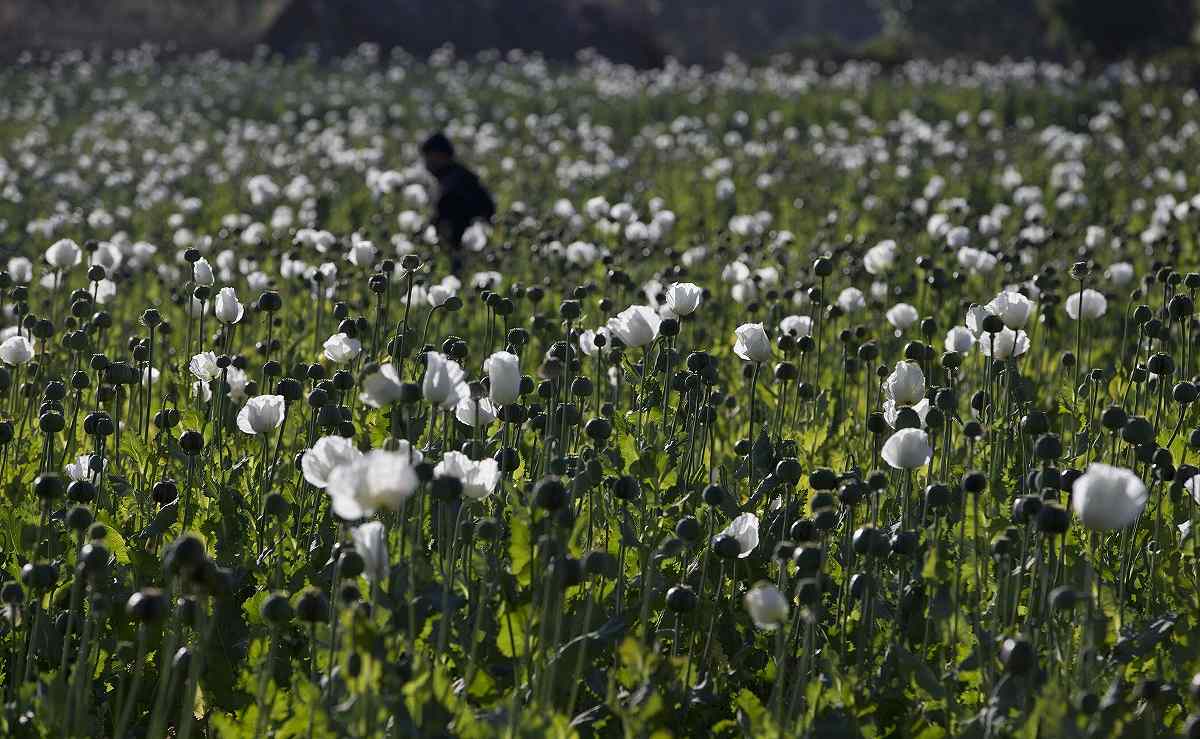
A villager walks in a flourishing poppy field at Nampatka village, Northern Shan State, Myanmar, in January 2014.
17:40 JST, February 4, 2023
BANGKOK (AP) — The production of opium in Myanmar has flourished since the military’s seizure of power, with the cultivation of poppies up by a third in the past year as eradication efforts have dropped off and the faltering economy has led more people toward the drug trade, according to a United Nations report released on Jan. 26.
In 2022, in the first full growing season since the military wrested control of the country from the democratically elected government of Aung San Suu Kyi in 2021, Myanmar saw a 33% increase in cultivation area to 40,100 hectares according to the report by the U.N. Office on Drugs and Crime.
“Economic, security and governance disruptions that followed the military takeover of February 2021 have converged, and farmers in remote, often conflict-prone areas in northern Shan and border states have had little option but to move back to opium,” said the U.N. office’s regional representative Jeremy Douglas.
The overall value of the Myanmar opiate economy, based on U.N. estimates, ranges between $660 million and $2 billion, depending on how much was sold locally, and how much of the raw opium was processed into heroin or other drugs.
“Virtually all the heroin reported in East and Southeast Asia and Australia originates in Myanmar, and the country remains the second-largest opium and heroin producer in the world after Afghanistan,” Douglas said. “There is no comparing the two at this point as Afghanistan still produces far more, but the expansion underway in Myanmar should not be dismissed and needs attention as it will likely continue — it is directly tied to the security and economic situation we see unfolding today.”
The so-called Golden Triangle area, where the borders of Myanmar, Laos and Thailand meet, has historically been a major production area for opium and hosted many of the labs that converted it to heroin. Decades of political instability have made the frontier regions of Myanmar, also known as Burma, largely lawless, to be exploited by drug producers and traffickers.
Most of the opium exported by Myanmar goes to China and Vietnam, while heroin goes to many countries across the region, Douglas said.
“It is really where the value is for traffickers,” he said. “Very high profits.”
The cultivation of opium had been trending downward in recent years before the military took control of the government in 2021.
Production estimates hit a bottom of 400 metric tons in 2020. After rising slightly in 2021, that spiked in 2022 to an estimated 790 metric tons, according to the report.
Since it took control of the government, the military’s use of deadly force to hold on to power has escalated conflict with its civilian opponents to the point that some experts describe the country as now being in a state of civil war.
The costs have been high, with 2,810 people killed by government forces to date and 17,427 detained, according to the Assistance Association for Political Prisoners.
The violence has meant that the government has been unable to reach some areas to carry out drug eradication raids, and has also had to divert its resources elsewhere. Consequently, eradication efforts appear to have decreased substantially, with 1,403 hectares reported eradicated in 2022 — some 70% fewer than in 2021.
At the same time, as the conflict continues to take its toll on Myanmar’s economy, an increasing number of rural households have been pushed into relying more on opium cultivation for income, the U.N. said.
“The expansion of opium production that is underway is fundamentally about poverty and people in rural areas reacting to the economic situation,” Douglas said. “It has always been there in tough times. At the same time, the security situation is clearly difficult with increasing frequency and intensity of conflict, and those involved in the drug economy have been left largely unchecked.”
Its synthetic drug economy has also been surging for the same reasons, with reported regional seizures of methamphetamine and other drugs reaching record levels. In a single bust in September in Laos, for example, authorities seized 33 million methamphetamine tablets along with 500 kilograms of crystal methamphetamine.
"World" POPULAR ARTICLE
-

8 Japanese Nationals Stranded on Indonesia’s Sumatra Island
-

Mozambican Cooking Class Held in Matsuyama, Ehime Pref.; Participants Don Aprons, Bandanas Made from Traditional Mozambique Fabric
-

China to Impose Sanctions on Shigeru Iwasaki, Former Head of Japan’s Self-Defense Forces, Who Serves as Adviser to Taiwan’s Executive Branch
-

U.S. Senate Resolution Backs Japan, Condemns China’s Pressure
-

South Korea’s Top Court Dismisses Nippon Steel Appeal in Lawsuit over Requisitioned Worker
JN ACCESS RANKING
-

Keidanren Chairman Yoshinobu Tsutsui Visits Kashiwazaki-Kariwa Nuclear Power Plant; Inspects New Emergency Safety System
-

Tokyo Economic Security Forum to Hold Inaugural Meeting Amid Tense Global Environment
-

Imports of Rare Earths from China Facing Delays, May Be Caused by Deterioration of Japan-China Relations
-

University of Tokyo Professor Discusses Japanese Economic Security in Interview Ahead of Forum
-

Japan Pulls out of Vietnam Nuclear Project, Complicating Hanoi’s Power Plans






















